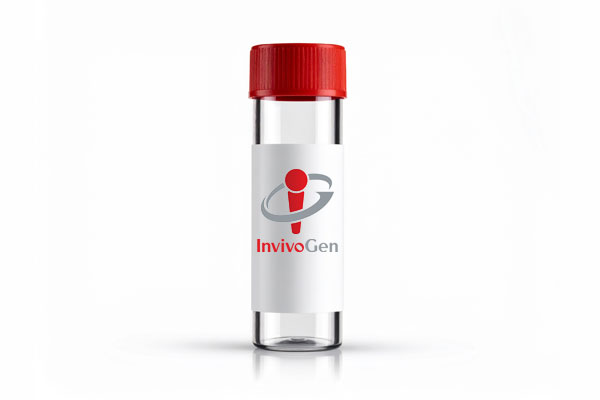Recombinant human RANKL
-
Cat.code:
rcyec-hranklNEW
- Documents
ABOUT
Human RANKL protein - E. coli-expressed, tag-free, carrier-free
Recombinant human RANKL is a high-quality and biologically active cytokine, validated using proprietary RANKL reporter cells. This member of the Tumor Necrosis Factor (TNF) superfamily is produced in E. coli and thoroughly purified to remove endotoxins.
Recombinant human RANKL can be used together with HEK-Blue™ RANKL cells for the screening of inhibitory molecules, such as Denosumab, a therapeutic monoclonal antibody blocking the RANKL cytokine from binding to its receptor RANK (see figures).
Key features
- Each lot is validated using HEK-Blue™ RANKL cells
- Endotoxin ≤1 EU/µg
- 0.2 µm sterile-filtered
Applications
- Standard for RANKL detection and quantification assays
- Screening and release assays for antibodies blocking RANKL signaling
- Screening and release assays for engineered RANKL
The Receptor Activator of NF-κB Ligand (RANKL) is a member of the TNF (Tumor Necrosis Factor) superfamily and plays a pivotal role in bone remodeling and dendritic cell survival. Blocking the binding of RANKL to its receptor RANK has been shown to reduce osteoporosis, prevent skeletal-related events (SREs) from bone metastasis in cancer, or improve anti-tumor immunity.
All products are for internal research use only, and not for human or veterinary use.
SPECIFICATIONS
Specifications
O14788
100 μg/ml in water
Solution containing Tris-HCl and NaCl
The absence of bacterial contamination (e.g. lipoproteins and endotoxins) has been confirmed using HEK-Blue™ TLR2 and HEK‑Blue™ TLR4 cells.
Cellular assays
Each lot is functionally tested and validated.
CONTENTS
Contents
-
Product:Recombinant human RANKL
-
Cat code:rcyec-hrankl
-
Quantity:10 µg
Shipping & Storage
- Shipping method: Room temperature
- -20°C
- Avoid repeated freeze-thaw cycles
Storage:
Caution:
Details
RANKL background
Receptor Activator of NF-κB Ligand (RANKL), also known as member 11 of the tumor necrosis factor (TNF) superfamily (TNFSF11) or TNF-related activation-induced cytokine (TRANCE), exists as a transmembrane or soluble protein produced by osteoblasts and activated T cells [1]. RANKL binds to its receptor RANK via an obligate trimer configuration [1, 2]. RANKL/RANK signaling plays a pivotal role in bone remodeling and dendritic cell survival, thereby enhancing the induction of T cell responses [1]. Upon RANKL binding, RANK trimers recruit TNF receptor-associated factor (TRAF) adaptor proteins, such as TRAF6, to TRAF-binding motifs within their cytoplasmic domains [1]. The TRAF6 signaling cascade results in the activation of NF-κB and AP-1 transcription factors. Multiple efforts have focused on the development of anti‑RANKL antibodies or small‑molecule inhibitors for blocking RANKL/RANK signaling to reduce osteoporosis, prevent skeletal-related events (SREs) from bone metastasis in cancer, or improve anti-tumor immunity [1-3].
1. Cheng ML. & Fong L., 2014. Effects of RANKL-targeted therapy in immunity and cancer. Front. Oncol. 3:329.
2. Ahern E. et al., 2018. Roles of the RANKL-RANK axis in anti-tumour immunity — implications for therapy. Nat. Rev. Clin. Oncol. 15:676-93.
3. Nakai Y. et al., 2019. Efficacy of an orally active small-molecule inhibitor of RANKL in bone metastasis. Bone Res. 7:1.
DOCUMENTS
Documents
Technical Data Sheet
Validation Data Sheet
Safety Data Sheet
Certificate of analysis
Need a CoA ?







